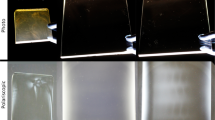Sodium sulfate is widely used as a fining agent in high-tonnage glass technology. Since the conditions for redox glassmaking and Fe2+↔Fe3+ equilibrium displacement are formed under the influence of sulfate, the glassmaking process and glass quality largely depend on the quality and particulars of sulfate interaction with a reducing agent. The reactions and stages of sulfate action in the batch and molten glass are examined.
Similar content being viewed by others
Notes
Here and below the content by weight, %.
References
M. A. Bezborodov, Synthesis and Structure of Silicate Glasses [in Russian], Nauka i tekhnika, Minsk (1968).
H. Jebsen-Marwedel, H. Bach, F. G. Baukke, and R. Brückner, Types of Rejects in Glass Production [Russian translation] Stroiizdat, Moscow (1986).
Yu. A. Guloyan, Physical-Chemical Principles of Glass Technology [in Russian], Tranzit-IKS, Vladimir (2008).
N. A. Pankova, N. Yu. Mikhailenko, and E. E. Stroginova, “Current problems of commercial glassmaking,” in: Selected Works of Prof. N. A. Pankov [in Russian], RKhTU im. D. I. Mendeleeva, Moscow (2005).
S. V. Zavarina, G. A. Polkan, A. A. Veshkina, and A. A. Bukharina, “Effect of oxidizers and reducing agents on glass quality,” in: Progress in Glass XXI [in Russian], Privolzhsk. Izd., Saratov (2005), pp. 20 – 26.
E. Adamets, L. Ya. Levitin, V. I. Litvin, et al., “Rational approaches to regulating the redox characteristics of batch for making float-glass,” Steklo Keram., No. 9, 3 – 11 (2011); J. Adamec, L. A. Levitin, V. I. Litvin, et al., Glass Ceram., 68(9), 273 – 281 (2011).
Yu. A. Sorin and A. S. Kutukov, “Sodium sulfate as an accelerator for making borosilicate glass,” Collection of Works of the State Institute of Glass [in Russian], Moscow (1984), pp. 98 – 102.
N. F. Zhernovaya, N. I. Min’ko, and V. I. Onishchuk, “Effectiveness of sulfate fining of alkali-free type-E glass,” Steklo Keram., No. 4, 7 – 9 (2003).
N. I. Min’ko, A. B. Atkarskaya, A. A. Myagkaya, and I. V. Tret’yakov, “Stabilization of the spectral characteristics and technology of glass,” Steklo Keram., No. 3, 18 – 21 (2011); N. I. Min’ko, A. B. Atkarskaya, A. A. Myagkaya and I. V. Tret’yakov, “Stabilizing the spectral properties and technologies of glass,” Glass Ceram., 68(3 – 4), 87 – 90 (2011).
I. D. Babinets, L. Ya. Levitin, and N. A. Pankova, “Some particulars of the change in gas content in molten glass along sheet-glass tank furnaces,” Fiz. Khim. Stekla, 4(2), 10–11 (1978).
N. G. Lipin, L. A. Orlova, and N. A. Pankova, “Evaluation of the redox potential of glass batches,” Steklo Keram., No. 11 – 12, 12 – 13 (1993); N. G. Lipin, L. A. Orlova, and N. A. Pankova, “Estimation of the redox potential of glass batches,” Glass Ceram., 50(11 – 12), 464 – 466 (1993).
A. L. Korshunov, “Redox potential as one glass quality control factor,” Steklyannaya Tara, No. 6, 10 – 11 (2003).
N. A. Pankova and S. I. Markov, “Silicate formation processes in wet batch,” Steklo Keram., No. 1, 2 – 4 (1994); N. A. Pankova and S. I. Markov, “Silicate formation in wet batch,” Glass Ceram., 51(1 – 2), 3 – 7 (1994).
N. I. Min’ko, R. V. Lavrov, and V. V. Varavin, “Sodium hydroxide in glass technology,” in: Progress in Glass XXI: Collection of Scientific Works [in Russian], Privolozhsk. Izd., Saratov (2010), pp. 130 – 135.
N. A. Pankova and N. Yu. Mikhailenko, Theory and Practice of Commercial Glass Production [in Russian], RKhTU im. D. I. Mendeleeva, Moscow (2000).
N. N. Semenov, A. Yu. Smirnova, and V. S. Bezlyudnaya, “Sulfide products of evaporation and condensation under float-process conditions,” Progress in Glass XXI: Collection of Scientific Works [in Russian], Privolozhsk. Izd., Saratov (2007), pp. 97 – 99.
Author information
Authors and Affiliations
Corresponding author
Additional information
Translated from Steklo i Keramika, No. 11, pp. 3 – 8, November, 2012.
Rights and permissions
About this article
Cite this article
Min’ko, N.I., Binaliev, I.M. Role of sodium sulfate in glass technology. Glass Ceram 69, 361–365 (2013). https://doi.org/10.1007/s10717-013-9479-8
Published:
Issue Date:
DOI: https://doi.org/10.1007/s10717-013-9479-8



